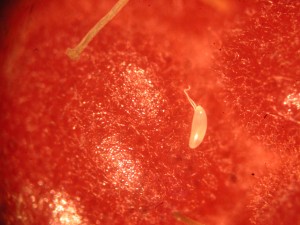Spotted Wing Drosophila, Drosophila suzukii (SWD) is a vinegar fly native to East Asia. The insect established in the Eastern US in 2012, and has become an invasive insect pest of small fruit and grape. In years of early emergence, it can have significant impact on the NYS cherry industry.
Synopsis: In Orange, Dutchess and Columbia Counties growers are finding ovipositional injury (punctures and eggs) with larva present in managed mid-season cherry fruit. In our SWD traps at the HVRL, placed in early June, we had our first observation of adult spotted wing Drosophila (SWD) Drosophila suzukii, on the 27th of June.
In Western NY, the first SWD adult capture was sited on May 31st followed by Suffolk trap captures finding SWD on June 1st. Needless to say, this is the earliest emergence of SWD in the state with economic loss from the pest in early season sweet cherry.
Late cherry varieties such as Regina, Sweetheart and Hudson should be protected on a tight program (3-7d) to reduce infestation from SWD as harvest continues. Pick your own blocks should, by design, be managed to alternate picking based on Pre-Harvest Intervals (PHI).
Management options for sweet and tart cherry are available on the tree fruit and grape guidelines for insecticide use, and should be used for treatment option decision making for this season as label changes and new materials have been added to the list. Raspberry and blackberry should be on a 3-4 day program and blueberry on a 7-day program. PDF files for Small fruit management guidelines for insecticide use can also be found using this link.
Overview: There are only three effective classes of insecticides labeled for use to manage spotted wing drosophila on sweet cherry. They include the pyrethroids (IRAC Class 3): Asana XL 0.66EC (esfenvalarate) and Lambda-Cy 1EC (lambda-cyhalothrin); and the Spinosad class: Delegate 25WG (spinetoram) and Entrust 2SC and 80WP (spinosad); and the Diamide (IRAC 28) Exirel. The organophosphate (IRAC Class 1): Imidan 70W (Phosmet) can only be used on tart cherry.
In conventional programs for cherry refer to the DTH chart to best accommodate management strategies up to harvest. From laboratory studies we have observed chilling of raspberry in 33-38F for 48-72hrs. to dramatically impact survival of larva and egg.
In SWD traps throughout the state, the adult has been observed in wild host plants including Tartarian Honeysuckle (Lonicera tatarica), and commercially managed sweet cherry, raspberry and blackberry, the latter two being a favored host of the SWD. Relative to blueberry and strawberry, raspberry and blackberry require considerably more intensive management strategies. In raspberry or blackberry patches where SWD have been captured and or fruit injury has been observed, management should begin at first adult capture followed by the first available application window to reduce the risk of initial adult egg laying. In these cultivars a tight management schedule of 3-4 days may be needed as populations continue to increase.

To date, SWD adults have been captured across NYS in all Hudson Valley counties including Suffolk, Orange, Dutchess, Columbia and Ulster in cherry, raspberry, blueberry and blackberry plantings as well as much of the fruit growing regions along Lake Ontario.
Given the increasing number of SWD finds we are seeing in the northeast, it would be wise to begin trapping efforts in cherry orchards, brambles and blueberry fields as flies increase from localized to regional populations. Although damage has occurred and may appear low in isolated Hudson Valley fruit farms, It is likely that SWD damage to small fruit will ramp up significantly over the upcoming week as temperatures rise and adults establish and build in population across the region.
Monitoring for SWD adults: Employing traps to monitor the first emergence of the adult on your farm is the most effect method to determine the start of SWD management. Traps can be made of red plastic 16 oz. solo cups and lids. Traps can be baited with apple cider vinegar (ACV), as the attractant killing solution. Approximately 30, 1/8″ holes, are drilled around the top 3/4 of the cup, leaving a 3′ gap to pour out the ACV solution in a strip of 2″ x 2″ netting to access the number of captured flies. A yeast, flour & sugar bait mixed with water needs to be added to a smaller container (5.0 oz.or so) fixed position cup along the top edge. Additional trap manufacturing information.
Conventional and Organic Management Options for NYS grown small fruit: Fewer tools are available for organic management of the SWD. Organic Management of Spotted Wing Drosophila can be enhanced through the use of various tactics and strategies. These include:
1. Optimizing organic plant protectant timings, rotation of insecticide and use of feeding enhancements (sugars) and biological controls, to establish the best possible use of current options for SWD management while reducing the impact on pollinators and non-target natural enemies.
2. Monitor the SWD to begin management at the onset of adult activity.
3. Employ cultural management practices including organic attract and kill, netted exclusion of plant canopy, address sanitation and orchard / berry floor management to reduce infestation and population buildup.
4. Develop harvest and cold storage system to reduce berry infestation.

Cultural control: Rotating plots within a block may be needed to maintain daily harvesting while cleaning the brambles of all fruit to reset management and eliminate eggs and larva in fruit as an important part of late season management strategies. Removal and complete destruction of infested berries will also reduce newly developing populations to aid in management. Keeping fruit cold (34-38F) directly after harvest will arrest egg and larval development. Prolonged exposure to these low temperatures for 3-4d will dramatically reduce egg and larva survival.
Additional SWD Resources:
The Cornell Spotted Wing Drosophila web site hosts a map of the counties in which SWD is being trapped.
Updates on presence based on trap findings.
Information on insect biology.





